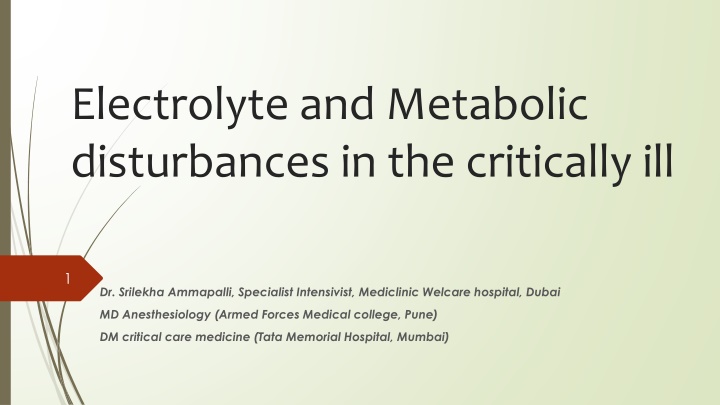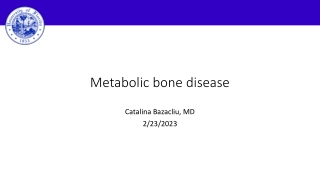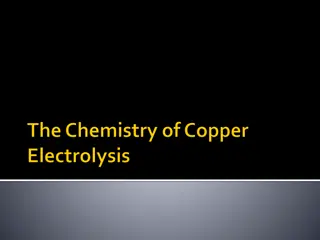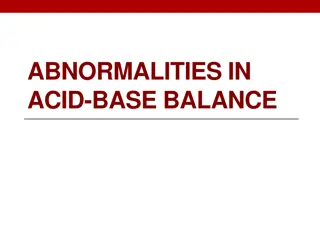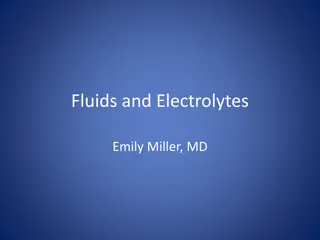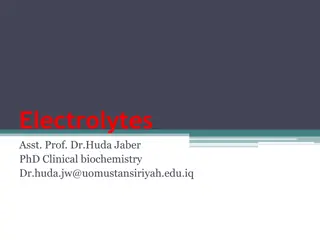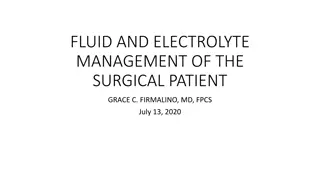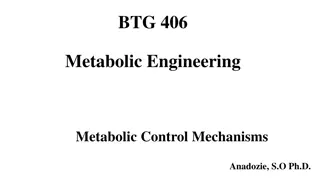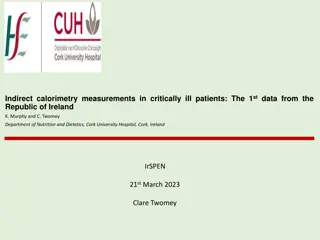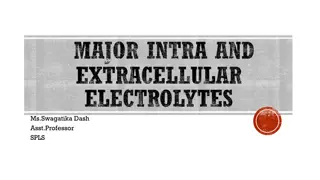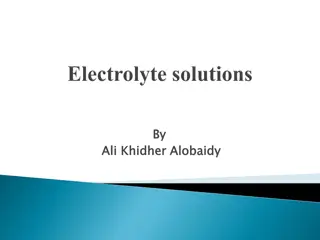Electrolyte and Metabolic Disturbances in the Critically Ill
Dr. Srilekha Ammapalli discusses the cations (sodium, potassium, calcium, magnesium) and anions (chloride, bicarbonate, phosphate, lactate) involved in electrolyte and metabolic disturbances in critically ill patients. The physiology, causes of abnormalities, diagnosis, evaluation, and management of these disturbances are covered, along with the impact of non-ionic solutes like glucose and urea. The role of sodium, hypernatremia, its symptoms, and treatment approaches are also highlighted.
Download Presentation

Please find below an Image/Link to download the presentation.
The content on the website is provided AS IS for your information and personal use only. It may not be sold, licensed, or shared on other websites without obtaining consent from the author.If you encounter any issues during the download, it is possible that the publisher has removed the file from their server.
You are allowed to download the files provided on this website for personal or commercial use, subject to the condition that they are used lawfully. All files are the property of their respective owners.
The content on the website is provided AS IS for your information and personal use only. It may not be sold, licensed, or shared on other websites without obtaining consent from the author.
E N D
Presentation Transcript
Electrolyte and Metabolic disturbances in the critically ill 1 Dr. Srilekha Ammapalli, Specialist Intensivist, Mediclinic Welcare hospital, Dubai MD Anesthesiology (Armed Forces Medical college, Pune) DM critical care medicine (Tata Memorial Hospital, Mumbai)
Cations: Sodium Potassium Calcium Magnesium 2 Anions: Chloride Bicarbonate Phosphate Lactate Brief Physiology Causes of abnormalities Diagnosis and evaluation Management Non- ionic solutes Glucose Urea
Sodium 3 Gibbs-Donnan Effect Anionic plasma proteins attract sodium into the plasma ? 60mmol/kg of sodium ? Dominant extracellular cation and solute An equilibrium is reached where the sodium concentration in the plasma remains slightly higher, and the chloride concentration in the plasma is slightly lower (chloride ends up being higher in the interstitial fluid) ? 70 kg male ? 92g of sodium 4200mmol of sodium ? ? 70% of this is exchangeable, and the rest is locked up in bone crystals ? Extracellular fluid contains 50% of the total body sodium Na+/K+ ATPase activity Sodium concentration inside the cell is kept artificially low by the action of Na+/K+ ATPase, which exchanges 3 sodium atoms for every 2 potassium. ? Intracellular fluid contains 5% of the total body sodium ? Remaining in the connective tissue and exchangeable bone reserves
Hypernatremia 4 Raise in serum sodium concentration to > 145 mmol/ litre Predominantly a Water problem, than a problem of sodium homeostasis Decrease in total body water relative to electrolyte content Impaired thirst and/ or restricted access to water, often exacerbated by pathological conditions with increased fluid loss Common disorder among elderly patients Incidence in ICU 8.9% Hyperosmolality from the water loss leads to neuronal shrinkage and resultant brain injury Loss of volume leads to circulatory problems tachycardia, hypotension
Hypernatremia 5 Acute symptomatic hypernatremia , occurs in less than 24 hours, should be corrected rapidly Chronic (> 48 hrs), should be corrected more slowly due to risk of cerebral edema during treatment
The normal plasma osmolality (Posm) lies between 275 and 290 mOsm/kg and is primarily determined by the concentration of sodium salts. Calculated plasma osmolality: 2(Na) mEq/L + serum glucose (mg/dL)/18 + BUN (mg/dL)/2.8 Regulation occurs by two mechanisms Changes in water intake Thirst Changes in water excretion Secretion of AVP
AVP The stimulus for AVP secretion is an activation of hypothalamic osmoreceptors, which occurs when the plasma osmolality reaches a certain threshold (approximately 280 mOsm/kg). AVP binds to the V2 receptor located on the basolateral membrane of the principal cells of the renal collecting ducts. G-protein coupled receptor initiates a signal transduction cascade, leading to phosphorylation of aquaporin-2 and its translocation and insertion into the apical (luminal) membrane, creating "water channels" that enable the absorption of free water
Thirst : Mediated by osmoreceptors located in the anteroventral hypothalamus. The osmotic thirst threshold approximately 288-295 mOsm/kg. So effective that even in pathologic states in which patients are unable to concentrate their urine and excrete excessive amounts of urine (10-15 L/d), hypernatremia does not develop because thirst is stimulated and body fluid osmolality is maintained at the expense of profound secondary polydipsia
Causes of hypernatremia Renal free water loss Diuretics (Loop and thiazide diuretics) Osmotic diuresis (Hyperglycemia, mannitol, urea, High protein tube feeding) Post obstructive diuresis Diuretic phase of acute tubular necrosis Extrarenal water loss GI Vomiting, diarrhea, lactulose, cathartics, nasogastric suction, gastrointestinal fluid drains, fistulas Cutaneous sweating, burn injuries Pure water deficits Water intake less than insensible losses may result from any of the following: Lack of access to water (through incarceration, restraints, intubation, immobilization) Altered mental status (through medications, disease) Neurologic disease (dementia, impaired motor function) Abnormal thirst (eg, geriatric hypodipsia; osmoreceptor dysfunction (reset of the osmotic threshold); injury to the thirst centers by any lesions to the hypothalamus, including from metastasis, granulomatous diseases, vascular abnormalities, and trauma; autoantibodies to the sodium- level sensor (Na x) in the brain Loss of water through the respiratory tract Nephrogenic diabetes insipidus Hypercalcemia Hypokalemia Lithium Pyelonephritis Medullary sponge kidney Multiple myeloma Amyloid Sarcoid Central Diabetes Insipidus Traumatic brain injury Pituitary tumour Meningitis Encephalitis Tuberculosis Sarcoidosis Idiopathic Hypertonic sodium gain Administration of hypertonic electrolyte solutions - Eg, sodium bicarbonate solutions, hypertonic alimentation solutions, normal saline with or without potassium supplements Sodium ingestion - NaCl tablets, seawater ingestion Sodium modeling in hemodialysis 9
Treatment of hypernatremia 10 Recommendations are as follows: Establish documented onset (acute, < 24 h; chronic, >24h) In acute hypernatremia, correct the serum sodium at an initial rate of 2-3 mEq/L/h (for 2-3 h) (maximum total, 12 mEq/L/d). Measure serum and urine electrolytes every 1-2 hours Perform serial neurologic examinations and decrease the rate of correction with improvement in symptoms Chronic hypernatremia with no or mild symptoms should be corrected at a rate not to exceed 0.5 mEq/L/h and a total of 8-10 mEq/d (eg, 160 mEq/L to 152 mEq/L in 24 h). If a volume deficit and hypernatremia are present, intravascular volume should be restored with isotonic sodium chloride prior to free-water administration
Free water deficit calculation 11 Adrogue Madias ? TBW = Body weight * correction factor Correction factor is Adult male: 60% (0.6) ? Adult female: 50% (0.5) ? Elderly male: 50% (0.5) ? Elderly female: 45% (0.45) ? Child: 60% (0.6) 1. Free water deficit = TBW * Current sodium/ Ideal sodium -1) 2. Change in serum Na+= (infusate Na+- serum Na+) (TBW + 1) ?
Free water replacement 12 Common infusates and their Na+contents Infusate Sodium concentration (mmol/litre) 0 34 77 130 D5 water Normal saline Normal saline Ringer s lactate Normal saline 154
Free water replacement 13 In stable patients with chronic hypernatremia, increased enteral free water may be sufficient to correct free water deficit ? Most patients, however require parenteral free water replacement with goal ? Half of free water deficit in the first 24 hrs Remaining free water deficit over next 48 hrs
Questions 1. Calculate the free water deficit for a male patient with hypernatremia with serum sodium of 160mmol/L. (Ideal sodium is 140mmol/L) 1. What should be the volume of 5% dextrose needed to correct the serum sodium to 140 mmol/L?
Other recommendations If hypernatremia is accompanied by hyperglycemia with diabetes, when using a glucose-containing replacement fluid, the appropriate use of insulin will help during correction In hypervolemic and hypernatremic patients who have an impaired renal excretion of sodium and potassium , an addition of a loop diuretic to free water boluses increases renal sodium excretion. Fluid loss during loop diuretic therapy must be restored with the administration of fluid that is hypotonic to the urine Once hypernatremia is corrected, treat the underlying cause Such efforts may include free access to water and better control of diabetes mellitus. Correction of hypokalemia and hypercalcemia as etiologies for nephrogenic diabetes insipidus may be required. Vasopressin (AVP, DDAVP) should be used for the treatment of central diabetes insipidus.
Hyponatremia 16 Serum sodium concentration <135 meq/litre Most common electrolyte abnormality (Prevalence in ICU 34.3%) Mild: 130-134 mmol/L Moderate: 125-129 mmol/L Profound or severe: < 125 mmol/L Hypo-osmolality (serum osmolality < 275 mOsm/kg) always indicates excess total body water relative to body solutes Solute depletion, solute dilution, or a combination of both
When there is an acute drop in the serum osmolality, neuronal cell swelling occurs due to the water shift from the extracellular space to the intracellular space (ie, Starling forces). Swelling of the brain cells elicits the following two osmoregulatory responses: It inhibits both arginine vasopressin secretion from neurons in the hypothalamus and hypothalamic thirst center. This leads to excess water elimination as dilute urine. There is an immediate cellular adaptation with loss of electrolytes, and over the next few days, a more gradual loss of organic intracellular osmolytes
Euvolemic Hypovolemic Hypervolemic Low urinary sodium Low urinary sodium Low urinary sodium Sodium preservation, an appropriate reaction to low blood volume by the kidneys Inappropriate water retention due to apparent hypovolemia 19 Hypovolemia Congestive heart failure Vomiting Cirrhosis Psychogenic polydipsia Diarrhea Nephrotic syndrome Beer potomania Blood loss Excessive sweating Burns Pancreatitis High urinary sodium High urinary sodium High urinary sodium Hypothyroidism Inappropriate sodium excretion; Usually because the nephron fails at reclaiming sodium Sodium wasting, the kidneys are responsible in some way Glucocorticoid deficiency Thiazide diuretics Acute renal failure Hypoadrenalism Aldosterone deficinecy Chronic renal failure SIADH Renal tubular acidosis Hypoadrenalism Cerebral salt wasting OSmotic diuresis Ketonuria Bicarbonate wasting in metabolic alkalosis
Hyponatremia diagnosis 20 Diagnosis of SIADH Normo- osmolar hyponatremia typically occurs due to high triglycerides, high serum protein, and use of glycine (TURP syndrome) ? Hyperosmolar hyponatremia occurs due to hyperglycemia, mannitol, sorbitol, maltose, and radiocontrast dye ?
Treatment of hyponatremia 22 European guidelines
Follow-up management in case of no improve- ment of symptoms after a 5 mmol/l increase in serum sodium concentration in the first hour, regardless of whether hyponatraemia is acute or chronic
Acute hyponatremia without severe or moderately severe symptoms
Managing overcorrection of chronic hyponatremia Infusion containing electrolyte free water (10ml/kg) over 1hour with or without 2mcg desmopressin IV every 8 hours Management of hypovolemic hyponatremia: Isotonic saline or balanced solution at 0.5 to 1ml/kg/hr Managment of euvolemic hyponatremia Fluid restriction (first line) Urea or loop diuretics + oral nacl (second line) Do not recommend vaptans Lithium or demeclocycline is not recommended Management of hypervolemic hyponatremia Fluid restriction. Recommend against vaptans or demeclocycline
Potassium physiology 40mmol/Kg of potassium. A 70kg male has about 2800mmol, or about 109g of potassium. Of this, 90% is in the intracellular fluid. This is the only exchangeable potassium. Extracellular fluid contains 2% of the total body potassium, and bone contains 8%
Regulation of potassium Intake is not regulated (passive paracellular gut absorption) Renal elimination is 95% of the total daily potassium excretion. Transcellular flux maintains homeostasis of the ECF potassium concentration Physiological role of potassium: Maintenance of intracellular fluid tonicity / regulation of cell volume Maintenance of resting membrane potential Responsible for the excitability of excitable tissues, action potentials etc Structural function (incorporated into bone, ribosomes, DNA and RNA) Intracellular and extracellular messenger function (mediator of nociception, inflammation, vasodilation) Elimination is influenced by: Oral potassium intake Produces immediate kaliuresis; intestinal K+sensor is implicated Aldosterone Increases renal elimination by increasing the activity of ENaC channels in the nephron Increases GI elimination in colon (5% of total) High potassium intake: leads to the increased expression of ROMK channels High distal sodium delivery: compensatory increase in potassium secretion to maintain electroneutrality. Acid-base disturbances: metabolic acidosis causes distal potassium secretion to decrease
Hyperkalemia Artefactual and spurious Delay in separating RBCs Hemolysis High platelet count Excessive potassium intake Blood transfusion Iatrogenic (eg; Infusion) Dietary salt substitutes Several no-salt or low-salt substitutes contain about 10-12 mEq of potassium per gram and can be dangerous, especially with diminished kidney function Penicillin G potassium therapy Disorders that can cause type IV renal tubular acidosis, resulting in hyperkalemia, include the following: Diabetes mellitus Sickle cell disease or trait Lower urinary tract obstruction Adrenal insufficiency Primary Addison syndrome due to autoimmune disease, tuberculosis, or infarct Enzyme deficiencies Genetic disorders Decreased Excretion Potassium sparing diuretics like spironolactone, triamterene, amiloride ACE inhibitors Angiotensin receptor blockers Cyclosporine or tacrolimus Pentamidine Trimethoprim- sulfamethaxazole Mineralocorticoid receptor antagonists NSAIDS Heparin Ketoconazole Hypoadrenalism Renal failure 31 Compartment shift Acidosis Betadrenergic blockade Acute tubular necrosis Electrical burns Thermal burns Cell depolarisation Head trauma Digoxin overdose Fluoride toxicity Cyclosporine Methotrexate Propofol infusion syndrome Rhabdomyolysis Tumor lysis syndrome Succinylcholine Insulin deficiency Hyperkalemic periodic paralysis
Clinical features of hyperkalemia Neurological effects Paraesthesia Weakness and flaccid paralysis (Diaphragm is usually spared) Loss of reflexes Normal cranial nerves Normal sensory function Biochemical abnormalities ECG changes 5.5-6.5 mEq/L. Peaked T waves with a narrow base, best seen in precordial leads ; shortened QT interval; and ST-segment depression. Normal anion gap metabolic acidosis (due to decreased renal ammoniagenesis) 6.5-8.0 mEq/L, in addition to peaked T waves, the ECG shows the following: Cardiovascular effects Hypotension Bradycardia Prolonged PR interval Decreased or disappearing P wave Widening of the QRS Amplified R wave Higher than 8.0 mEq/L, Absence of P wave progressive QRS widening, and Intraventricular/fascicular/bundle-branch blocks. The progressively widened QRS eventually merges with the T wave, forming a sine wave pattern. Ventricular fibrillation or asystole
Management of hyperkalemia 1. Correct Serious Conduction Abnormalities (Calcium) Calcium is a very useful agent. It does not lower the serum potassium level, but instead is used to stabilise the myocardium, as a temporising measure. Calcium is indicated if there is widening of QRS, sine wave pattern (when S and T waves merge together), or in hyperkalaemic cardiac arrest. The cardiac membrane stabilising effects take about 15-30mins. Calcium Chloride Dose: Calcium Chloride 10% 5-10mL 3 x more potent than Calcium gluconate Complication: severe thrombophlebitis Calcium Gluconate: Dose: Calcium gluconate 10% 5-10mL Less potent, less irritating to veins Potential Complications of Calcium administration Bradycardia, hypotension and peripheral vasodilation Generally these occur if administered too quickly Avoid in digoxin toxicity (use magnesium as alternative)
Management of hyperkalemia 2. Drive Potassium into the Cell: Insulin & Glucose Dose: IV fast acting insulin (actrapid) 10-20 units and glucose/dextrose 50g 25-50ml Insulin drives potassium into cells and administering glucose prevents hypoglycaemia. Begins to work in 20-30mins reduces potassium by 1mmol/L and ECG changes within the first hour Sodium Bicarbonate Dose: 50- 200mmol of 8.4% Sodium Bicarbonate Bicarbonate is only effective at driving potassium intracellularly if the patient is acidotic Begins working in 30-60 minutes and continues to work for several hours. Salbutamol Dose: 10-20mg via nebulizer Beta 2 agonist therapy lower K via either IV or nebulizer route. Salbutamol can lower potassium level 1mmol/L in about 30 minutes, and maintain it for up to 2 hours. Very effective in renal patients that are fluid overloaded 3.
3. Eliminate Potassium From the Body: Calcium resonium Dose: 15-45g orally or rectally, mixed with sorbitol or lactulose Calcium polystyrene sulfonate is a large insoluble molecule that binds potassium in the large intestine, where it is excreted in faeces Effects take 2-3 hours Frusemide Dose: 20-80mg depending on hydration status Potassium wasting diuretic. Helps to urinary excrete potassium in conjunction with hydration or fluid overloaded patients Normal Saline Used to help renally excrete potassium, by increasing renal perfusion and urinary output. Cautious use in patients with renal & heart failure Dialysis Is the gold standard for removing potassium from the body. Provides immediate and reliable removal. Can lower potassium by 1mmol/L in first hour and another 1mmol/L over the next 2 hours.
Hypokalemia Increased excretion 36 Mineralocorticoid excess (endogenous or exogenous) Hyperreninism from renal artery stenosis Osmotic diuresis: Mannitol and hyperglycemia can cause osmotic diuresis Increased gastrointestinal losses Drugs Genetic disorders Endogenous sources of excess mineralocorticoid include the following: Cushing syndrome Primary hyperaldosteronism, most commonly from an adrenal adenoma or bilateral adrenal hyperplasia Seco;o//p;l.ondary hyperaldosteronism from volume depletion, congestive heart failure, cirrhosis, or vomiting Tumor that is producing adrenocorticotropic hormone Genetic disorders Exogenous causes of mineralocorticoid excess include the following: Steroid therapy for immunosuppression Glycyrrhizic acid - Inhibits 11-beta hydroxysteroid dehydrogenase; contained in licorice and Chinese herbal preparations Renal tubular disorders - Type I and type II renal tubular acidosis Hypomagnesemia Extracellular/intracellular shift Intracellular shifts of potassium often are episodic and frequently are self-limited, as, for example, with acute insulin therapy for hyperglycemia. Alkalosis (metabolic or respiratory) Insulin administration or glucose administration (the latter stimulates insulin release) Intensive beta-adrenergic stimulation Hypokalemic periodic paralysis Thyrotoxic periodic paralysis Refeeding: This is observed in prolonged starvation, eating disorders, and alcoholism Hypothermia Gastrointestinal losses, Diarrhea Vomiting, or Nasogastric suctioning Vomiting leads to hypokalemia via a complex pathogenesis. Gastric fluid itself contains little potassium, approximately 10 mEq/L. It produces volume depletion and metabolic alkalosis Volume depletion leads to secondary hyperaldosteronism, which in turn leads to enhanced cortical collecting tubule secretion of potassium in response to enhanced sodium reabsorption. Metabolic alkalosis also increases collecting tubule potassium secretion due to the decreased availability of hydrogen ions for secretion in response to sodium reabsorption. There is a high prevalence of hypokalemia in patients with severe COVID-19 disease
Hypokalemia Drugs that can cause hypokalemia include the following: Diuretics (carbonic anhydrase inhibitors, loop diuretics, thiazide diuretics): Increased collecting duct permeability or increased gradient for potassium secretion can result in losses Methylxanthines (theophylline, aminophylline, caffeine) Verapamil (with overdose) Quetiapine (particularly in overdose) Ampicillin, carbenicillin, high-dose penicillins Bicarbonate Antifungal agents (amphotericin B, azoles, echinocandins) [21, 22] Gentamicin Cisplatin Ephedrine (from Ephedra; banned in the United States, but available over the Internet) [23] Beta-agonist intoxication Genetic disorders The following genetic disorders may result in hypokalemia: Congenital adrenal hyperplasia (11- beta hydroxylase or 17-alpha hydroxylase deficiency) Glucocorticoid-remediable hypertension Bartter syndrome Gitelman syndrome Liddle syndrome Gullner syndrome Glucocorticoid receptor deficiency Hypokalemic periodic paralysis Thyrotoxic periodic paralysis (TTPP) Seizures, sensorineural deafness, ataxia, mental retardation, and electrolyte imbalance (SeSAME syndrome)
Physical examination findings Weakness Decreased muscle tone Complications of prolonged hypokalemia Rhabdomyolysis Polyuria due to nephrogenic DI Features of History Ileus Failure to wean from ventilation Coma ECG findings Ventricular tachycardia: classically, torsades de pointes Atrial tachycardias PR interval prolongation (>200 msec) P wave amplitude increased (>2.5 mm in limb leads, >1.5 mm in chest leads) P wave width increased (>120 msec) u-waves T-wave inversion Ectopics (ventricular and atrial)
Treatment Reduction of potassium losses Replenishment of potassium stores Evaluation for potential toxicities Determination of the cause to prevent future episodes Decreasing Potassium Losses Measures to identify and stop ongoing losses of potassium include the following: Discontinue diuretics/laxatives Use potassium-sparing diuretics if diuretic therapy is required (eg, severe heart failure) Treat diarrhea or vomiting Administer H2 blockers to patients receiving nasogastric suction Control hyperglycemia if glycosuria is present Replenishment of Potassium For every 1 mEq/L decrease in serum potassium, the potassium deficit is approximately 200-400 mEq. this calculation could either overestimate or underestimate the true potassium deficit Eg: do not overcorrect potassium in patients with periodic hypokalemic paralysis. This condition is caused by transcellular maldistribution, not by a true deficit.
Mild to moderate Capsules or tablets: 40-100 mEq PO qDay in divided doses; single dose not to exceed 25 mEq to minimize GI discomfort Oral solution: 40-100 mEq PO qDay in 2 to 5 divided doses; limit single doses to 40 mEq/dose; not to exceed 200 mEq/24hr Aternatively, 10-20 mEq PO BID/QID (20-80 mEq/day) Severe hypokalemia 40 mEq PO TID/QID; may also administer 20 mEq PO BID/TID in addition to IV potassium administration with careful monitoring; doses >40 mEq are typically not well tolerated orally, resulting in GI irritation and nausea IV intermittent infusions 10 mEq/hr; repeat as needed based on lab values done frequently; central line infusion and continuous ECG monitoring recommended for infusions >10 mEq/hr 10 mEq of potassium chloride increases serum potassium levels by approximately 0.1 mEq/.L Dosing based on serum potassium 2.5-3.5 mEq/L: 10 mEq/hr maximum infusion rate; 40 mEq/L maximum concentration; not to exceed 200 mEq dose/24hr <2.5 mEq/L or symptomatic hypokalemia (excluding emergency treatment of cardiac arrest): 40 mEq/hr maximum infusion rate (central line only) in presence of continuous ECG monitoring and frequent lab monitoring; patients may require up to 400 mEq/24hr Hypokalemia Prophylaxis: 20-40 mEq PO qDay or divided BID
Composition of commonly used potassium supplements Oral Potassium chloride (KCl) Most commonly used formulation. Especially useful in patients with metabolic alkalosis (since potassium chloride will increase the serum chloride level). Slow-release microencapsulated (wax-matrix) KCl formulations are suboptimal if an immediate effect is desired. However, they may be better tolerated with less emesis Potassium citrate Potassium citrate is equally effective as KCl for the repletion of potassium Potassium citrate be useful in patients with nonanion-gap metabolic acidosis (NAGMA). The citrate will be converted into bicarbonate, thereby improving the acidosis. Commonly contains 2 mEq of potassium per ml.
Why should we replace magnesium? Magnesium is an important cofactor for the use of ATP by exchange pump Na -K - ATPase Hypomagnesemia impairs Na- k - ATPase, decreases cellular uptake of potassium Magnesium also decreases renal potassium excretion by influencing the action of the an inward rectifying k channel which is responsible for potassium flow into the lumen to maintain electroneutrality when ENAC channel reabsorbs sodium under the influence of aldosterone
Question no. 3: What is the cause? How do you treat?
Calcium physiology 360mmol/ kg of calcium in the body 25 moles of calcium 70 kg male has 25 moles of calcium or 1000 grams 99% in bone, 500mmol is exchanged between bone and ECF over a 24 hr period 30mmol of calcium is in the extracellular fluid, 7mmol is in the circulating blood Intracellular calcium is minimal, it is an important second messenger It is kept out of the cell actively by ATP powered pumps; It s important for it to stay out because it is a second messenger
Calcium metabolism Vitamin D Group of related sterols Cholecalciferol is formed in the skin -> in liver to 25-hyrdroxcholecalciferol -> in kidney proximal tubules to 1,25-dihydroxycholecalciferol -> this then helps calcium Absorption in the intestine. Controlled by parathyroid hormone -> increases intestinal absorption of Ca2+ -> increases renal Ca2+ reabsorption -> mobilises bone Ca2+ and PO43 Parathyroid hormone secretion increased by hypocalaemia & hypomagnesaemia secretion decreased by hypercalcaemia & hypermagnesaemia -> mobilses Ca2+ from bone -> increases renal Ca2+ reabsorption -> increases renal PO43 excretion -> increases formation of 1, 25-dihyroxycholecalciferol. Calcitonin antagonist of parathyroid hormone secreted by the parafollicular cells of the thyroid gland in response to: hypercalcaemia catecholamines gastrin -> inhibits the mobilisation of bone Ca2+ -> increases renal Ca2+ and PO43- excretion
Calcium disorders 47 Effective serum calcium concentration in a critically ill patient is best determined by ionised calcium concentration For every change in albumin by 1gram/dl, the total calcium concentration changes by 0.8 mg/dl Highly regulated cation An important second messenger Involved in: cell death, duration and strength of cardiac muscle contraction, muscle contraction in blood vessels, airways and uterus, coagulation, bone metabolism, neurotransmitter and hormone release Ionized Ca2+ concentration is inversely related to pH -> an increase in pH results in a decrease in ionized Ca2+
Causes of hypercalcemia PTH mediated hypercalcemia increased calcium absorption from the intestine. Granulomatous disorders: High levels of calcitriol may be found in patients with sarcoidosis and other granulomatous diseases. the increased level of calcitriol results from production within the macrophages, which constitute a large portion of some granulomas. Iatrogenic: In some cases, elevation of calcium is a known adverse effect of appropriate dosage. In other cases, large ingestions must be taken to induce the increase in calcium levels. Obtain a complete review of current medications for patients presenting with hypercalcemia. Record any vitamin use Neoplasms (nonparathyroid) - Metastasis to the bone from breast, multiple myeloma, and hematologic malignancies (Breast cancer is one of the most common malignancies responsible for hypercalcemia.) Nonmetastatic (humoral-induced) - Ovary, kidney, lung, head and neck, esophagus, cervix, lymphoproliferative disease, multiple endocrine neoplasia, pheochromocytoma, and hepatoma Pharmacologic agents - Thiazide, calcium carbonate (antacid), hypervitaminosis D, hypervitaminosis A, lithium, milk-alkali syndrome, and theophylline toxicity Endocrinopathies (nonparathyroid) - Hyperthyroidism, adrenal insufficiency, and pheochromocytom Familial hypocalciuric hypercalcemia Tertiary hyperparathyroidism - Post renal transplant and initiation of chronic hemodialyis 48 Non PTH mediated hypercalcemia Hypercalcemia associated with malignancy: 1. Generally worsens until therapy is provided 2. Result of increased osteoclastic activity within the bone. 3. Two mechanisms a. Extensive localized bone destruction may result from osteolytic metastasis of solid tumors. Malignant cells may release local osteoclastic activating factors. b. PTH related protein This protein is a humeral factor that acts on the skeleton to increase bone reabsorption; it acts on the kidney to decrease excretion of calcium. The gene that produces this protein is present in many malignant tissues.
Clinical manifestations of hypercalcemia Cardiovascular Renal Shortened QT interval on ECG Arrhthymias (rare unless on digitalis) Bradycardia Hypertension Bundle branch/AV blocks Polyuria Polydispsia Nocturia Hypercalciuria Nephrolithiasis Nephrocalcinosis Renal failure Neuromuscular Emotional lability Confusion Delirium Psychosis Stupor Muscle weakness Headache Seizures (rare) Gastrointestinal Nausea/vomiting Anorexia Constipation Abdominal pain Peptic ulcers Pancreatitis Skeletal Bone pain/arthralgia Osteopenia/osteoporosis in cortical bone (often seen in wrist)
Hypercalcemia treatment 50 Dilute serum calcium Decrease calcium resorrtion from bone Calcitonin Bisphosphonates Gallium nitrate Mithramycin (for malignant disease) Decrease calcium resorption from the renal tubules Loop diuretics (this has fallen out of favour) Calcitonin Decrease calcium absorption from the gut Corticosteroids (also they decrease the 1,25-dihydroxyvitamin D production by monocytes within granulomae) Forcibly remove excess calcium from the circulation Haemodialysis EDTA administration (as chelating agent) Rehydration with IV fluids
